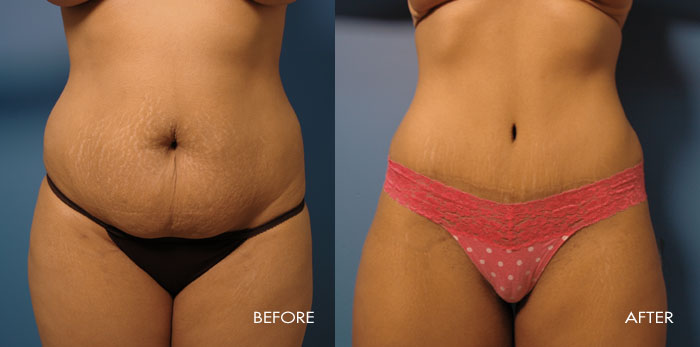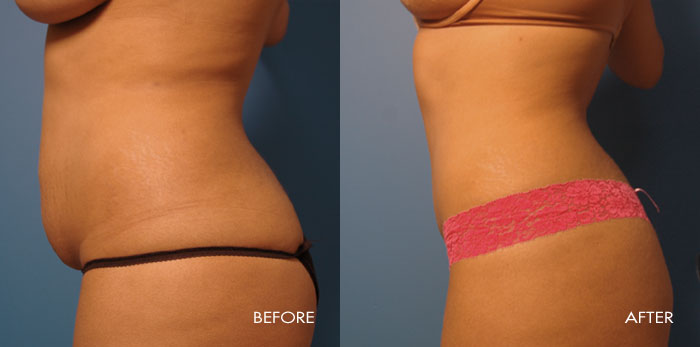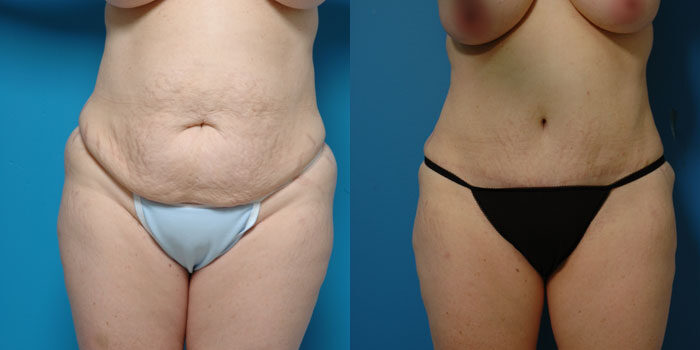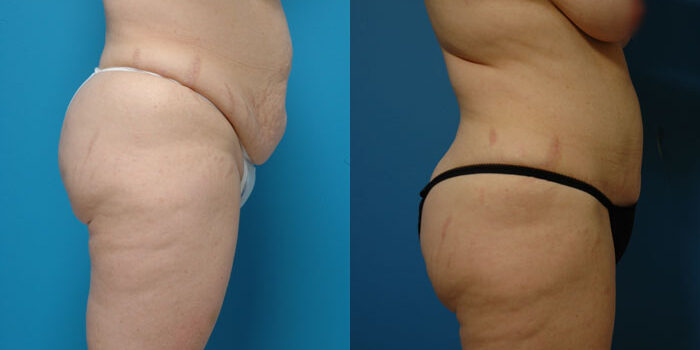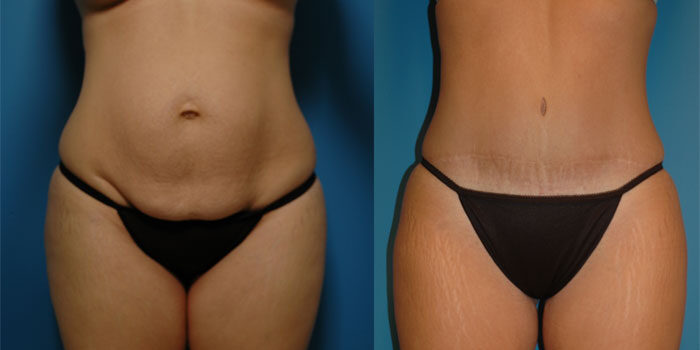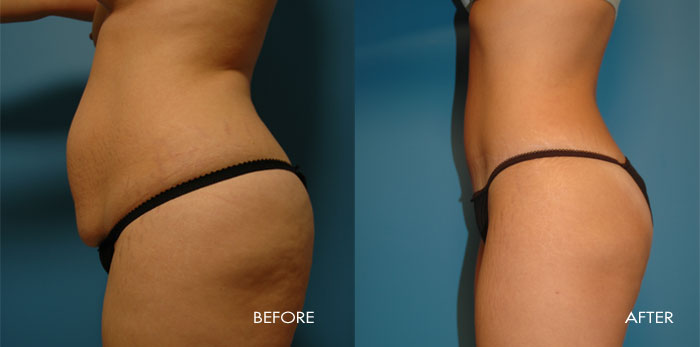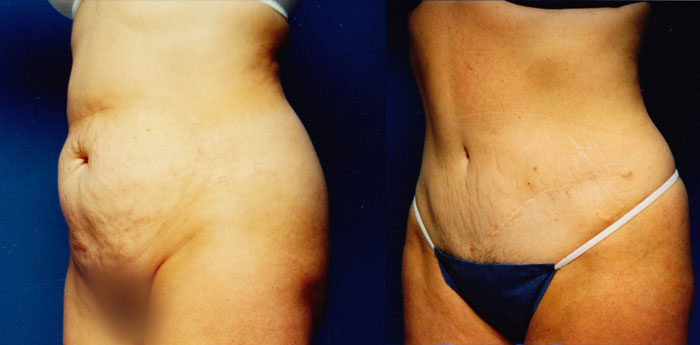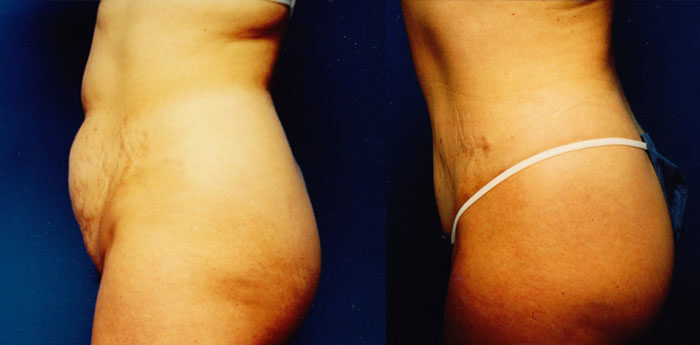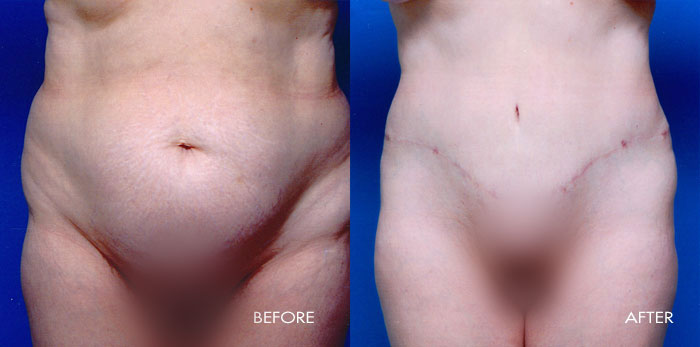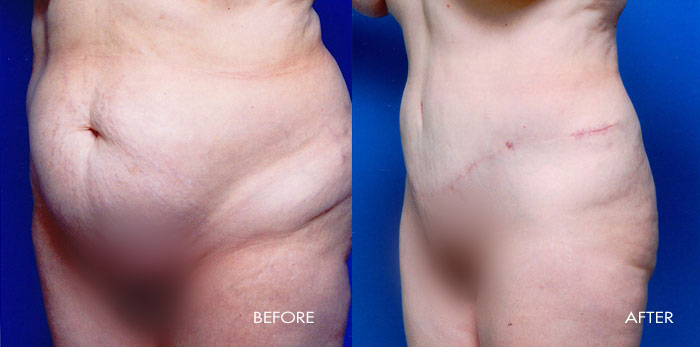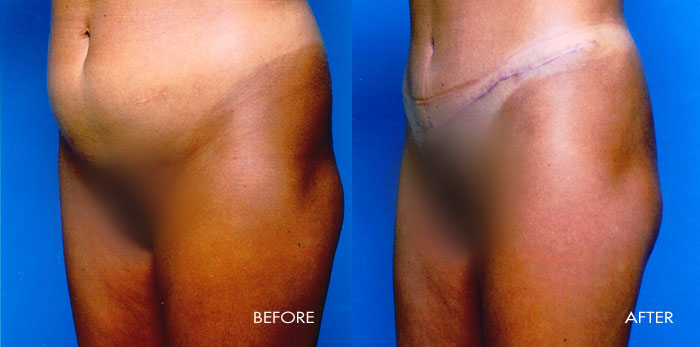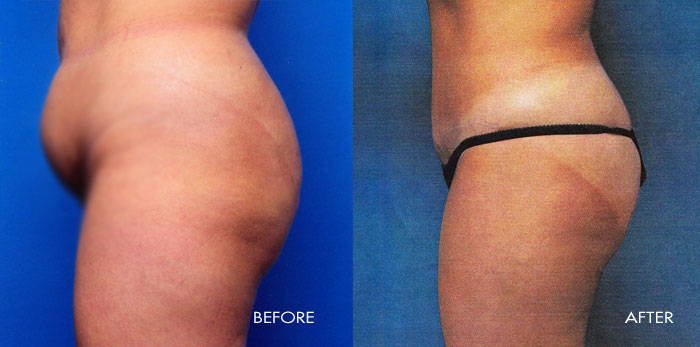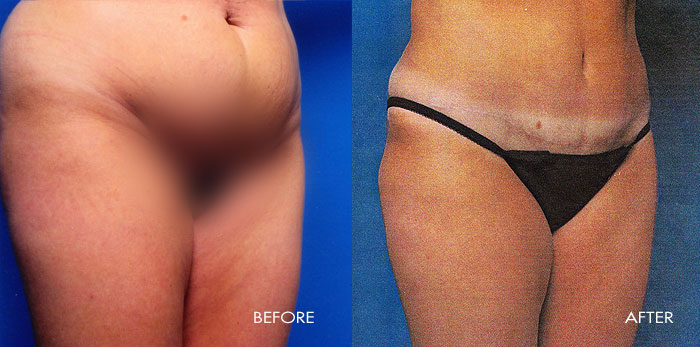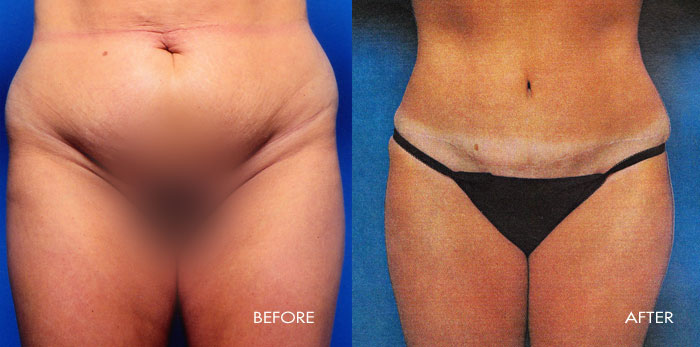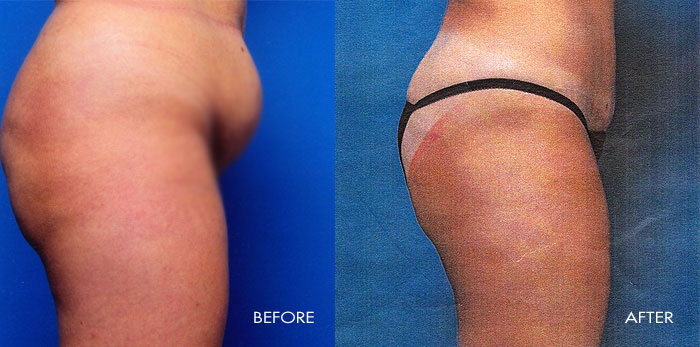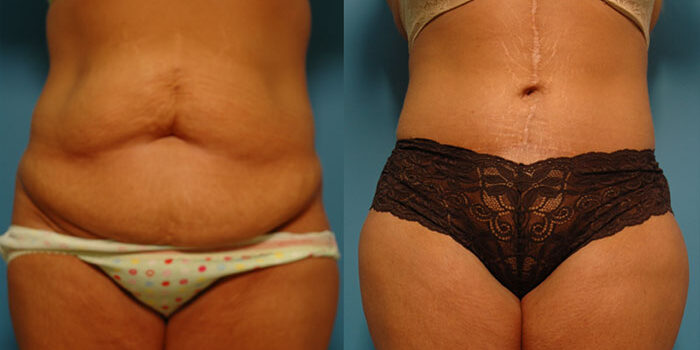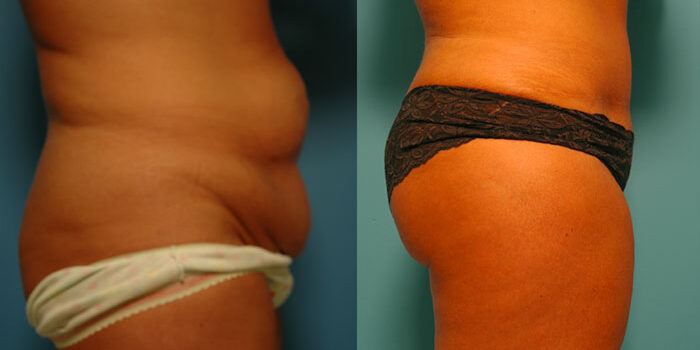Abdominoplasty
Standard Abdominoplasty
(with or without Liposuction)
As opposed to liposuction, which is typically performed to only remove unwanted fat from relatively skin-tight abdomens, tummies which demonstrate unwanted fat, stretched muscles and loose skin will require some form of abdominoplasty, usually in conjunction with liposuction to achieve the best results. Liposuction alone does not tighten loose skin, but after removing excess skin and fat by adominoplasty, and after tightening the stretched muscles, liposuction can be added to liposculpt the final result.
A standard abdominoplasty is necessary when patients present with significant muscle stretching and loose skin in both the upper and lower abdomen and waist areas. The traditional approach involves a more extended, straight incision in the lower abdomen with limited liposuction capability. Modern techniques have evolved to enhance these results through strategic incision placement and comprehensive tissue manipulation. This evolution in surgical approach has led to improved outcomes and higher patient satisfaction rates. The procedure addresses multiple aesthetic concerns, including excess skin removal, muscle repair and overall contour enhancement.
Mini Abdominoplasty
The recommendation for a mini abdominoplasty is based on the patient’s amount and location of loose skin and muscle. If the primary problem area exists below the belly button as a small amount of loose skin, the patient may be a candidate for this less invasive procedure. Mini abdominoplasty results in tightening loose muscles above the umbilicus and a shorter incision in the lower abdomen, typically slightly longer than a C-section scar. This technique works particularly well for patients with minimal upper abdominal laxity and good skin elasticity. The reduced surgical scope often translates to shorter recovery times and less post-operative discomfort than complete abdominoplasty procedures.
Liposuction with BodyTite or Renuvion or short-scar techniques of lower abdominal skin tightening plus liposuction with BodyTite or Renuvion are then utilized to treat any unwanted fat in the remaining trunk areas, such as the waist, which also must be relatively tight.
High Lateral Tension Abdominoplasty
The High Lateral Tension Abdominoplasty represents a significant advancement in surgical technique. This sophisticated approach creates an incision low in the abdomen, similar to a C-section scar’s location but curved upward toward the hip bone. This positioning allows superior skin tightening in the front and waist areas while improving upper thigh contours. The technique enables more extensive liposuction in both front and back waist areas compared to traditional methods, enhancing overall body contouring. The advanced approach gives surgeons greater control over final aesthetic outcomes and typically yields more natural-looking results.
In the early 1990s a newer method, the High Lateral Tension Abdominoplasty, was introduced. Dr. Samuels pursued additional training to learn this technique and now uses it for most patients who require standard abdominoplasty. Also, more liposuction is possible in the front and back of the waist than with the older method. The procedure is very popular in Dr. Samuels’ practice, as she is one of the only surgeons in the area who offers this technique. High Lateral Tension Abdominoplasty makes body contouring of the entire trunk now possible in a single procedure.
Abdominoplasty usually takes four to six hours, depending on the extent of work required. The additional time is due to the amount of sculpting that Dr. Samuels is able to perform with liposuction.
The incision usually runs from hipbone to hipbone, and may be a V-cut or U-cut shape so that the scar is hidden in a two-piece bikini. The next incision in made around the belly button, freeing it from surrounding tissue; therefore, the belly button may have a cat’s eye appearance after surgery.
Technical Procedure Details
Surgical Approach
The procedure begins with precise surgical marking in the upright position to define tissue removal boundaries, incision locations and liposuction zones. The lower abdominal incision placement respects natural skin folds, typically residing 6-7 centimeters above the anterior vulvar commissure in women or at the pubic hairline in men. Strategic marking incorporates key anatomical landmarks while planning optimal scar concealment and tissue redistribution. Careful consideration of individual patient anatomy ensures customized treatment planning for optimal results.
Muscle Repair Methodology
During surgery, the rectus abdominis muscles undergo careful evaluation and measurement of diastasis recti separation. A specialized layered plication technique using permanent sutures creates an internal corset effect, significantly improving core strength and abdominal contour. Depending on individual patient needs, this repair may incorporate both horizontal and vertical muscle tightening. Advanced suturing methods ensure durable repair while maintaining natural muscle function and movement. The comprehensive muscle repair approach provides aesthetic and functional benefits for patients.
Tissue Management
Strategy Successful abdominoplasty requires meticulous management of multiple tissue layers. The surgical team preserves the superficial fascial system to maintain optimal blood supply to the abdominal skin. Careful dissection protects lymphatic channels, minimizing post-operative swelling. Umbilical reconstruction employs specialized techniques to create natural-appearing results with appropriate depth and contour. Layered closure methods promote optimal healing and reduce complication risks. The strategic approach to tissue handling ensures long-lasting results while minimizing recovery time.
Recovery Process
Initial Phase
Recovery management begins immediately post-surgery with comprehensive monitoring and comfort control. Pain management follows a multimodal approach combining regional anesthesia, nerve blocks and oral medication protocols. Drainage systems require systematic monitoring with careful output documentation. Position changes occur at regular intervals to promote circulation and prevent complications. Early ambulation begins within 24 hours following specific safety protocols. Compression garments provide essential support while minimizing fluid accumulation and promoting tissue adherence. The initial recovery phase typically spans the first week post-surgery and requires close medical supervision.
Intermediate Recovery
The first three weeks mark critical healing milestones. Drainage removal occurs based on consistent output measurements typically ranging between 25-30cc per 24 hours. Physical activity increases gradually with specific protocols guiding advancement. Wound care transitions from acute management to long-term scar optimization. Professional lymphatic massage often begins during this phase to reduce swelling and enhance results. Patients typically return to light daily activities following individual healing progression markers. This phase focuses on gradually increasing activity levels while maintaining optimal healing conditions.
Advanced Recovery
Months one through three demonstrate progressive improvement in function and appearance. Exercise routines advance systematically through established protocols, beginning with walking and progressing to more strenuous activities. Scar management intensifies by utilizing combination therapy approaches, including topical treatments, silicone therapy and sun protection. Swelling continues to resolve through activity modification and compression therapy. Regular follow-up evaluations guide activity advancement and monitor healing progression. The advanced recovery phase establishes long-term maintenance protocols for optimal results.
Advanced Technology Integration
Modern abdominoplasty procedures often incorporate BodyTite or Renuvion technologies for enhanced results. These sophisticated systems utilize radiofrequency energy and helium plasma to achieve superior skin-tightening results in the remaining trunk areas. The waist area mainly benefits from this combined approach, as these technologies allow for precise tissue remodeling and skin contraction without additional scarring. Treatment protocols are customized based on individual tissue characteristics and desired outcomes. The integration of these advanced technologies has revolutionized the field of body contouring by providing surgeons with tools to achieve more dramatic results while minimizing surgical trauma.
Radiofrequency Systems
Modern abdominoplasty procedures often incorporate radiofrequency-assisted lipolysis through the BodyTite system. This technology delivers precise thermal energy to multiple tissue layers, simultaneously maintaining internal temperatures at 70°C while external temperatures remain safely between 38-42°C. This controlled thermal delivery achieves immediate fat liquefaction, collagen contraction and enhanced skin retraction. Tissue quality continues improving through long-term collagen remodeling, extending throughout recovery. The integration of radiofrequency technology has significantly enhanced surgical outcomes.
Plasma Technology
Renuvion technology represents the latest advancement in tissue contraction utilizing helium plasma combined with radiofrequency energy. This minimally invasive system creates instant tissue fiber contraction while maintaining safe temperature profiles. Benefits include immediate tissue response with minimal surrounding tissue effect. The technology enables reduced procedural time, leading to faster recovery periods. Continuous monitoring systems ensure consistent energy delivery, maintaining optimal safety parameters. The addition of plasma technology has expanded treatment options for challenging cases.
Combined Procedures
Comprehensive Rejuvenation
Abdominoplasty frequently serves as the foundation for comprehensive body contouring procedures. Mommy makeover combinations synchronize breast enhancement procedures with abdominal contouring, creating balanced rejuvenation. Strategic liposuction of adjacent areas ensures smooth transitions between treated zones. Nonsurgical skin treatments complement surgical intervention, enhancing overall tissue quality. Treatment planning prioritizes safety while maximizing aesthetic improvement. The combination of procedures provides patients with dramatic transformative results.
Body Contouring After Weight Loss
Significant weight loss patients require specialized approaches that address multiple areas simultaneously. Traditional abdominoplasty techniques adapt to manage extensive skin laxity patterns. Vertical skin excision becomes necessary to address significant tissue redundancy. Lower body lifting procedures treat circumferential tissue excess. Concurrent hernia repair integrates seamlessly when indicated. Lateral tissue management ensures comprehensive improvement in body contour. These specialized techniques address unique challenges presented by massive weight loss patients.
Quality of Life Improvements
Successful abdominoplasty delivers significant functional improvement beyond aesthetic enhancement. Core strength increases substantially through precise muscular repair and subsequent rehabilitation. Physical activity capacity expands as abdominal wall integrity improves. Posture enhancement occurs naturally through proper muscle realignment. Daily activities become easier with restored muscle function. Exercise capacity increases progressively through recovery. Many patients report improved back pain symptoms and enhanced athletic performance following complete healing. The functional benefits often extend to improved respiratory function and increased exercise tolerance.
Aesthetic Outcomes
Physical transformation extends well beyond basic contour improvement. Clothing fits properly with restored body proportions. Skin quality improves through advanced tissue manipulation techniques. Scar maturation continues with appropriate management protocols. Natural-appearing results develop through careful surgical planning and execution. Patient confidence typically increases significantly with improved body image. The psychological benefits often include enhanced self-esteem and improved social interaction. Many patients feel more comfortable participating in physical activities and wearing a broader range of clothing styles.
Long-term Care
Maintenance Protocols Long-term success requires dedicated maintenance protocols. Weight management prevents stress on surgical repairs. Exercise routines maintain core strength and general fitness levels. Skin care regimens protect and enhance surgical results. Regular medical evaluation ensures continued improvement. Lifestyle modifications support lasting results through proper nutrition and activity levels. Ongoing commitment to healthy habits maximizes the longevity of surgical results. Patients receive comprehensive guidance on maintaining their results through various life changes and aging processes.
Schedule an Abdominoplasty Consultation
Our experienced surgical team will create a customized treatment plan addressing your specific needs and aesthetic goals. During your consultation, we’ll discuss your concerns, evaluate your candidacy and develop a comprehensive surgical plan tailored to your objectives. Our dedication to patient education ensures you’ll completely understand the procedure, recovery process and expected outcomes.
Contact our office at 502-806-8876 or visit here to request your consultation appointment. Join the many satisfied patients who have achieved their body contouring goals through our expertise in abdominoplasty procedures.
Frequently Asked Questions
A tummy tuck may be performed on an outpatient basis with an extended or overnight stay in our fully Quad A accredited in-suite surgical facility. You must be sure to arrange for someone to drive you home after surgery and stay with you for at least the next day or two. A medication called Exparel is infused over the abdominal wall muscles during surgery to numb the core sit-up muscles which are tightened, and this provides incredibly effective pain control to our tummy tuck patient for at least four days post-operatively.
Often, a general anesthetic is administered so that you are asleep throughout the procedure. A tummy tuck may be performed using local anesthesia and intravenous sedation. When surgery is completed, you will be taken to a recovery area where you will continue to be closely monitored. In many instances, small drain tubes will have been placed within the abdominal tissues to help avoid accumulation of fluids. Gauze or other dressings may be applied to your abdomen and covered with tape or an elastic bandage.
You will be encouraged to take short walks to promote blood circulation the day after surgery. Try not to sit for long periods of time during the first several days and avoid straining, bending and lifting. Our surgical team will instruct you to sleep on your back with a pillow under your knees. Drains will be removed on post-operative days 5-7 and 12-14. Sutures around your new belly button will be removed at the time of the second drain removal, and you will be given a compression garment to support your tummy on the day of the last drain removal. All other sutures except those around your belly button will dissolve on their own. Bruising and some swelling will occur and disappear over a period of weeks. The swelling may take months to subside before you see the final results of your tummy tuck. Even though the incisions from the procedure will heal and fade over time, it’s important to know that incision lines will be permanently visible.
Fortunately, most bathing suits and undergarments usually conceal tummy tuck incisions. You may be able to resume most of your normal activities anywhere from one to three weeks after surgery. Some mild, periodic discomfort may occur; if you experience any severe pains, they should be reported to Dr. Samuels.
During the consultation, Dr. Samuels will ask about the desired results you wish to achieve. If you plan to become pregnant or lose weight, discuss this with Dr. Samuels. Abdominoplasty is designed primarily for patients who are mostly satisfied with their weight but have excess skin and loose muscle around their midsections.
Ideal candidates maintain a stable weight within 10-15 pounds of their goal for at least six months. Good overall health, realistic expectations, and completion of family planning optimize outcomes. Smoking cessation becomes mandatory for at least six weeks before surgery. Physical conditioning focusing on core strength provides additional benefits. Candidates should demonstrate commitment to maintaining a healthy lifestyle following surgery. Mental preparation and understanding of the recovery process contribute significantly to successful outcomes.
The following conditions might indicate that a tummy tuck is right for you:
- Tightening excess skin to eliminate loose and sagging skin
- Tightening the underlying abdominal muscles to create a firmer abdominal wall
- Removing excess fat to eliminate a protruding tummy
- Maintaining a stable weight, with no plans for future pregnancies
Potential complications include seroma formation, delayed wound healing and infection. Risk minimization occurs through careful patient selection, meticulous surgical technique and proper post-operative care. Early intervention effectively addresses potential concerns. Regular follow-up ensures appropriate healing progression. While complications can occur, most are entirely resolved with appropriate medical management. Understanding warning signs and maintaining communication with the surgical team promotes early detection and intervention when needed.
Initial recovery requires one to two weeks of limited activity. Return to work varies between two and four weeks, depending on occupation requirements. Exercise resumption follows a graduated protocol over six to eight weeks. Complete recovery occurs over three to six months. Results continue improving through one year post-procedure. Individual healing rates vary based on multiple factors, including age, general health and adherence to post-operative instructions. Support systems play crucial roles in optimal recovery progression.
Results remain stable with maintained weight and healthy lifestyle choices. Proper skin care and sun protection preserve tissue quality. Core exercise routines maintain muscle repair strength. Additional procedures rarely become necessary with proper maintenance protocols. Long-term results depend significantly on patient commitment to healthy lifestyle practices. Regular follow-up appointments allow for monitoring results and early intervention if concerns arise.
Our practice utilizes advanced surgical techniques, including high lateral tension methods and modern technology integration. Customized treatment planning addresses individual patient needs. Comprehensive pre-operative optimization and detailed post-operative care maximize results. The combination of extensive experience and cutting-edge technology ensures optimal outcomes. Our team approach to patient care provides support throughout the entire surgical journey.
Before & After Results
